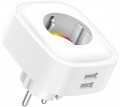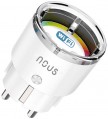USB port
The number of
USB outputs provided in the design of the smart socket/extension cable.
The main (and usually the only) purpose of such outlets is to charge various gadgets like smartphones and tablets, as well as power some accessories (for example, miniature desktop fans). And the number of USB ports corresponds to the number of devices that can be directly connected to an outlet/extension cable in this way. Due to the relatively small dimensions of such connectors, several of them are often provided — up to 4.
Maximum power
The maximum load power that can be connected to the network through a smart socket. If you plan to power several devices through the device, accordingly, you need to take into account their total power.
Permissible power
up to 2 kW is considered relatively low, but it is quite enough for most household appliances that do not have high power consumption. For example, such values will be enough for a household lamp, a medium-sized TV, a home air conditioner, a microwave oven, etc. Devices with a maximum power
of 2 to 3 kW are suitable for more “gluttonous” equipment like an electric kettle or boiler. And the most “hardy” smart sockets are limited
from 3 to 3.5 kW, they will be compatible with any electrical appliances that are generally designed to work from an outlet (recall, power of more than 3.5 kW requires connection directly to the shield, ordinary sockets are no longer designed for it).
Maximum load
The maximum load current for which the smart socket is designed. This parameter is directly related to the maximum power (see above) — we recall that the power is calculated by multiplying the current by the voltage. Thus, if the maximum power is, for example, 2200 W, then the maximum load will be 2200/220 = 10 A.
The permissible load of
less than 10 A for modern smart sockets is considered low,
11 – 15 A is considered average, and the maximum indicator is actually
16 A — ordinary wall sockets do not initially assume a higher load. Equipment that consumes a current of more than 16 A requires a special connection with special control automation; smart sockets are not used for such devices.
Operating temperature
The operating temperature of the device is the range of ambient air temperatures at which the socket / extension cord is guaranteed to remain operational.
All smart sockets and extension cords easily tolerate “room” conditions with a temperature comfortable for a person. Therefore, if the device is bought for an ordinary residential or office space, you can ignore this indicator. But if the outlet / extension cord is to be used in a more extreme environment (for example, in an unheated garage), you should make sure that the selected model can normally endure the corresponding temperatures. This is especially true with regard to resistance to cold:
frost -resistant devices can be found on the market, but there are quite a few of them.

